Germination Energy, Germination Capacity and Microflora of Allium cepa L. Seeds after RF Plasma Conditioning
Abstract
1. Introduction
2. Materials and Methods
2.1. Cold Plasma Generator
2.2. Germination Energy and Capacity
2.3. SEM Analysis
2.4. Microbiological Analysis
3. Results and Discussion
3.1. Germination Energy and Capacity
3.2. SEM Analysis
3.3. Microbiological Analysis
4. Conclusions
Supplementary Materials
Author Contributions
Funding
Data Availability Statement
Acknowledgments
Conflicts of Interest
References
- Adam, E.; Mühlbauer, W.; Esper, A.; Wolf, W.; Spiess, W. Quality changes of onion (Allium cepa L.) as affected by the drying process. Food Nahr. 2000, 44, 32–37. [Google Scholar] [CrossRef]
- Todkari, G.U.; Barakade, A.J.; Lokhande, T.N. Economics of onion cultivation and it’s marketing pattern in satara district of Maharashtra. Int. J. Agric. Sci. 2011, 3, 110–117. [Google Scholar]
- Sohn, B.-K.; Cho, J.-S.; Kang, J.-G.; Cho, J.-Y.; Kim, K.-Y.; Kim, H.-W.; Kim, H.-L. Physico-Chemical Properties of Soils at Red Pepper, Garlic and Onion Cultivation Areas in Korea. Korean J. Soil Sci. Fertil. 1999, 32, 123–131. [Google Scholar]
- Khan, M.A.; Hasan, M.K.; Miah, M.A.J.; Alam, M.M.; Masum, A. Effect of plant spacing on the growth and yield of different varieties of onion. Pak. J. Biol. Sci. 2003, 6, 1582–1585. [Google Scholar] [CrossRef]
- Ray, J.; Paul, D.; Mitra, A.; Chaudhuri, R.; Sarkar, D. A case study on resource-use efficiency in Onion cultivation in West Bengal, India. Econ. Aff. 2016, 61, 321. [Google Scholar]
- Schmidt, N.; Zinkernagel, J. Model and Growth Stage Based Variability of the Irrigation Demand of Onion Crops with Predicted Climate Change. Water 2017, 9, 693. [Google Scholar] [CrossRef]
- Kowalska, B.; Smolinska, U. Soil incorporation of cruciferous plant residues as a control strategy for Pantoea ananatis colonization of onion seedlings. J. Plant Pathol. 2015, 97, 235–242. [Google Scholar]
- Kalbarczyk, R.; Kalbarczyk, E. The adverse effect of the long-term trend of the air temperature in Poland on the yield of onion. J. Cent. Eur. Agric. 2015, 16, 41–53. [Google Scholar] [CrossRef][Green Version]
- Sharma, K.; Lee, Y.R.; Park, S.W.; Nile, S.H. Importance of growth hormones and temperature for physiological regulation of dormancy and sprouting in onions. Food Rev. Int. 2016, 32, 233–255. [Google Scholar] [CrossRef]
- Khokhar, K.M. Environmental and genotypic effects on bulb development in onion—A review. J. Hortic. Sci. Biotechnol. 2017, 92, 448–454. [Google Scholar] [CrossRef]
- Ciesielska, B.; Wawrzyniak, J. Change of Vegetables Production in Poland between 1997–2012. J. Agribus. Rural Dev. 2013, 29, 17–27. [Google Scholar]
- Tarnowska, A. Supply side competitiveness of Polish vegetable sector in the European Union. Econ. 21st Century 2014, 3, 23–24. [Google Scholar]
- Kim, M.Y.; Lee, S.H.; Jang, G.Y.; Park, H.J.; Li, M.; Kim, S.; Lee, Y.R.; Noh, Y.H.; Lee, J.; Jeong, H.S. Effects of high hydrostatic pressure treatment on the enhancement of functional components of germinated rough rice (Oryza sativa L.). Food Chem. 2015, 166, 86–92. [Google Scholar] [CrossRef] [PubMed]
- De Souza, A.; García, D.; Sueiro, L.; Gilart, F. Improvement of the seed germination, growth and yield of onion plants by extremely low frequency non-uniform magnetic fields. Sci. Hortic. 2014, 176, 63–69. [Google Scholar] [CrossRef]
- Sujak, A.; Dziwulska-Hunek, A.; Kornarzyński, K. Compositional and nutritional values of amaranth seeds after pre-sowing He-Ne laser light and alternating magnetic field treatment. Int. Agrophys. 2009, 23, 81–86. [Google Scholar]
- Kornarzyński, K.; Dziwulska-Hunek, A.; Kornarzyńska-Gregorowicz, A.; Sujak, A. Effect of Electromagnetic Stimulation of Amaranth Seeds of Different Initial Moisture on the Germination Parameters and Photosynthetic Pigments Content. Sci. Rep. 2018, 8, 14023. [Google Scholar] [CrossRef]
- Krawiec, M.; Dziwulska-Hunek, A.; Sujak, A.; Palonka, S. Laser irradiation effects on Scorzonera (Scorzonera hispanica L.) seed germination and seedling emergence. Acta Sci. Pol. Hortorum Cultus 2015, 14, 145–158. [Google Scholar]
- Sujak, A.; Dziwulska-Hunek, A.; Reszczyńska, E. Effect of Electromagnetic Stimulation on Selected Fabaceae Plants. Pol. J. Environ. Stud. 2013, 22, 893–898. [Google Scholar]
- Dziwulska-Hunek, A.; Sujak, A.; Kornarzyński, K. Short-Term Exposure to Pre-Sowing Electromagnetic Radiation of Amaranth Seeds Affects Germination Energy but not Photosynthetic Pigment Content. Pol. J. Environ. Stud. 2013, 22, 93–98. [Google Scholar]
- Sakhnini, L. Influence of Ca2+ in biological stimulating effects of AC magnetic fields on germination of bean seeds. J. Magn. Magn. Mater. 2007, 310, e1032–e1034. [Google Scholar] [CrossRef]
- Bormashenko, E.; Grynyov, R.; Bormashenko, Y.; Drori, E. Cold Radiofrequency Plasma Treatment Modifies Wettability and Germination Speed of Plant Seeds. Sci. Rep. 2012, 2, 741. [Google Scholar] [CrossRef] [PubMed]
- Misra, N.; Moiseev, T.; Patil, S.; Pankaj, S.; Bourke, P.; Mosnier, J.-P.; Keener, K.M.; Cullen, P.J. Cold Plasma in Modified Atmospheres for Post-harvest Treatment of Strawberries. Food Bioprocess Technol. 2014, 7, 3045–3054. [Google Scholar] [CrossRef]
- Li, L.; Jiang, J.F.; Li, J.; Shen, M.; He, X.; Shao, H.; Dong, Y. Effects of cold plasma treatment on seed germination and seedling growth of soybean. Sci. Rep. 2014, 4, 5859. [Google Scholar]
- Kramer, A.; Bekeschus, S.; Matthes, R.; Bender, C.; Stope, M.B.; Napp, M.; Lademann, O.; Lademann, J.; Weltmann, K.D.; Schauer, F. Cold Physical Plasmas in the Field of Hygiene—Relevance, Significance, and Future Applications. Plasma Process. Polym. 2015, 12, 1410–1422. [Google Scholar] [CrossRef]
- Ohta, T. Chapter 8—Plasma in Agriculture. In Cold Plasma in Food and Agriculture; Misra, N.N., Schlüter, O., Cullen, P.J., Eds.; Academic Press: Cambridge, MA, USA, 2016; pp. 205–221. [Google Scholar] [CrossRef]
- Dobrin, D.; Magureanu, M.; Mandache, N.B.; Ionita, M.-D. The effect of non-thermal plasma treatment on wheat germination and early growth. Innov. Food Sci. Emerg. Technol. 2015, 29, 255–260. [Google Scholar] [CrossRef]
- Sarinont, T.; Amano, T.; Attri, P.; Koga, K.; Hayashi, N.; Shiratani, M. Effects of plasma irradiation using various feeding gases on growth of Raphanus sativus L. Arch. Biochem. Biophys. 2016, 605, 129–140. [Google Scholar] [CrossRef]
- Pawłat, J.; Starek, A.; Sujak, A.; Kwiatkowski, M.; Terebun, P.; Budzeń, M. Effects of atmospheric pressure plasma generated in GlidArc reactor on Lavatera thuringiaca L. seeds’ germination. Plasma Process. Polym. 2018, 15, 1700064. [Google Scholar] [CrossRef]
- Mitra, A.; Li, Y.-F.; Klämpfl, T.G.; Shimizu, T.; Jeon, J.; Morfill, G.E.; Zimmermann, J.L. Inactivation of Surface-Borne Microorganisms and Increased Germination of Seed Specimen by Cold Atmospheric Plasma. Food Bioprocess Technol. 2014, 7, 645–653. [Google Scholar] [CrossRef]
- Tylkowska, K.; Dorna, H. Onion (Allium cepa) seed and plant health with special reference to Botrytis allii. Phytopathol. Pol. 2001, 21, 55–68. [Google Scholar]
- Stankovic, S.; Levic, J.; Petrovic, T.; Logrieco, A.; Moretti, A. Pathogenicity and mycotoxin production by Fusarium proliferatum isolated from onion and garlic in Serbia. Eur. J. Plant Pathol. 2007, 118, 165–172. [Google Scholar] [CrossRef]
- Mancini, V.; Murolo, S.; Romanazzi, G. Diagnostic methods for detecting fungal pathogens on vegetable seeds. Plant Pathol. 2016, 65, 691–703. [Google Scholar] [CrossRef]
- Mancini, V.; Romanazzi, G. Seed treatments to control seedborne fungal pathogens of vegetable crops. Pest Manag. Sci. 2014, 70, 860–868. [Google Scholar] [CrossRef] [PubMed]
- Heller, L.C.; Edelblute, C.M.; Mattson, A.M.; Hao, X.; Kolb, J.F. Inactivation of bacterial opportunistic skin pathogens by nonthermal DC-operated afterglow atmospheric plasma. Lett. Appl. Microbiol. 2012, 54, 126–132. [Google Scholar] [CrossRef] [PubMed]
- Tyczkowska-Sieroń, E.; Markiewicz, J. Inactivation of Candida species using cold atmospheric plasma on the way to a new method of eradication of superficial fungal infections. Med. Dosw. Mikrobiol. 2014, 66, 121–129. [Google Scholar] [PubMed]
- Baldanov, B.B.; Ranzhurov, T.V.; Sordonova, M.N.; Budazhapov, L.V. Changes in the Properties and Surface Structure of Grain Seeds under the Influence of a Glow Dischargeat Atmospheric Pressure. Plasma Phys. Rep. 2020, 46, 110–114. [Google Scholar] [CrossRef]
- Lee, K.; Paek, K.; Ju, W.-T.; Lee, Y. Sterilization of bacteria, yeast, and bacterial endospores by atmospheric-pressure cold plasma using helium and oxygen. J. Microbiol. 2006, 44, 269–275. [Google Scholar]
- Bermúdez-Aguirre, D.; Wemlinger, E.; Pedrow, P.; Barbosa-Cánovas, G.; Garcia-Perez, M. Effect of atmospheric pressure cold plasma (APCP) on the inactivation of Escherichia coli in fresh produce. Food Control 2013, 34, 149–157. [Google Scholar] [CrossRef]
- Selcuk, M.; Oksuz, L.; Basaran, P. Decontamination of grains and legumes infected with Aspergillus spp. and Penicillum spp. by cold plasma treatment. Bioresour. Technol. 2008, 99, 5104–5109. [Google Scholar] [CrossRef]
- Zhang, X.; Liu, D.; Zhou, R.; Song, Y.; Sun, Y.; Zhang, Q.; Niu, J.; Fan, H.; Yang, S.-Z. Atmospheric cold plasma jet for plant disease treatment. Appl. Phys. Lett. 2014, 104, 043702. [Google Scholar] [CrossRef]
- Zahoranová, A.; Hoppanová, L.; Šimončicová, J.; Tučeková, Z.; Medvecká, V.; Hudecová, D.; Kaliňáková, B.; Kováčik, D.; Černák, M. Effect of Cold Atmospheric Pressure Plasma on Maize Seeds: Enhancement of Seedlings Growth and Surface Microorganisms Inactivation. Plasma Chem. Plasma Process. 2018, 38, 969–988. [Google Scholar] [CrossRef]
- Dasan, B.G.; Mutlu, M.; Boyaci, I.H. Decontamination of Aspergillus flavus and Aspergillus parasiticus spores on hazelnuts via atmospheric pressure fluidized bed plasma reactor. Int. J. Food Microbiol. 2016, 216, 50–59. [Google Scholar] [CrossRef] [PubMed]
- Šimončicová, J.; Kaliňáková, B.; Kováčik, D.; Medvecká, V.; Lakatoš, B.; Kryštofová, S.; Hoppanová, L.; Palušková, V.; Hudecová, D.; Ďurina, P.; et al. Cold plasma treatment triggers antioxidative defense system and induces changes in hyphal surface and subcellular structures of Aspergillus flavus. Appl. Microbiol. Biotechnol. 2018, 102, 6647–6658. [Google Scholar] [CrossRef] [PubMed]
- Filatova, I.; Azharonok, V.; Shik, A.; Antoniuk, A.; Terletskaya, N. Fungicidal Effects of Plasma and Radio-Wave Pre-treatments on Seeds of Grain Crops and Legumes. In Plasma for Bio-Decontamination, Medicine and Food Security; Machala, Z., Hensel, K., Akishev, Y., Eds.; Springer: Cham, Switzerland, 2012; pp. 469–479. [Google Scholar] [CrossRef]
- Waskow, A.; Betschart, J.; Butscher, D.; Oberbossel, G.; Klöti, D.; Büttner-Mainik, A.; Adamcik, J.; Von Rohr, P.R.; Schuppler, M. Characterization of Efficiency and Mechanisms of Cold Atmospheric Pressure Plasma Decontamination of Seeds for Sprout Production. Front. Microbiol. 2018, 9, 3164. [Google Scholar] [CrossRef] [PubMed]
- Basaran, P.; Basaran-Akgul, N.; Oksuz, L. Elimination of Aspergillus parasiticus from nut surface with low pressure cold plasma (LPCP) treatment. Food Microbiol. 2008, 25, 626–632. [Google Scholar] [CrossRef] [PubMed]
- Gamliel, A. Application aspects of integrated pest management. J. Plant Pathol. 2010, 92, 423–426. [Google Scholar]
- Kitazaki, S.; Koga, K.; Shiratani, M.; Hayashi, N. Growth Control of Dry Yeast Using Scalable Atmospheric-Pressure Dielectric Barrier Discharge Plasma Irradiation. Jpn. J. Appl. Phys. 2012, 51, 11PJ02. [Google Scholar] [CrossRef]
- Pawłat, J.; Terebun, P.; Kwiatkowski, M.; Diatczyk, J. RF atmospheric plasma jet surface treatment of paper. J. Phys. Appl. Phys. 2016, 49, 374001. [Google Scholar] [CrossRef]
- Pawłat, J.; Kwiatkowski, M.; Terebun, P.; Murakami, T. RF-Powered Atmospheric-Pressure Plasma Jet in Surface Treatment of High-Impact Polystyrene. IEEE Trans. Plasma Sci. 2016, 44, 314–320. [Google Scholar] [CrossRef]
- International Rules for Seed Testing; International Seed Testing Association: Walliselle, Switzerland, 2017.
- StatSoft, Inc. STATISTICA (Data Analysis Software System), StatSoft, Inc.: Tulsa, OK, USA, 2007.
- Kopacki, M.; Wagner, A. Effect of some fungicides on mycelium growth of Fusarium avenaceum (Fr.) Sacc. pathogenic to chrysanthemum (Dendranthema grandiflora Tzvelev). Agron. Res. 2006, 4, 237–240. [Google Scholar]
- Günes, F.; Ali, Ç. Seed Characteristics and Testa Textures some Taxa of Genus Lathyrus L. (Fabaceae) from Turkey. Int. J. Agric. Biol. 2011, 13, 888–894. [Google Scholar]
- Saranya, N.; Renugadevi, J.; Raja, K.; Rajashree, V.; Hemalatha, G. Seed priming studies for vigour enhancement in onion CO onion (5). J. Pharmacogn. Phytochem. 2017, 6, 77–82. [Google Scholar]
- Pawłat, J.; Starek, A.; Sujak, A.; Terebun, P.; Kwiatkowski, M.; Budzeń, M.; Andrejko, D. Effects of atmospheric pressure plasma jet operating with DBD on Lavatera thuringiaca L. seeds’ germination. PLoS ONE 2018, 13, e0194349. [Google Scholar]
- McAdam, E.L.; Brodribb, T.J.; McAdam, S.A.M. Does ozone increase ABA levels by non-enzymatic synthesis causing stomata to close? Plant Cell Environ. 2017, 40, 741–747. [Google Scholar] [CrossRef] [PubMed]
- Kaur, H.; Kohli, S.K.; Khanna, K.; Bhardwaj, R. Scrutinizing the impact of water deficit in plants: Transcriptional regulation, signaling, photosynthetic efficacy, and management. Physiol. Plant. 2021, 172, 935–962. [Google Scholar] [CrossRef]
- Lu, D.; Wang, T.; Persson, S.; Mueller-Roeber, B.; Schippers, J.H.M. Transcriptional control of ROS homeostasis by KUODA1 regulates cell expansion during leaf development. Nat. Commun. 2014, 5, 3767. [Google Scholar] [CrossRef]
- Song, Y.; Miao, Y.; Song, C.-P. Behind the scenes: The roles of reactive oxygen species in guard cells. New Physiol. 2014, 201, 1121–1140. [Google Scholar] [CrossRef]
- Adhikari, B.; Pangomm, K.; Veerana, M.; Mitra, S.; Park, G. Plant Disease Control by Non-Thermal Atmospheric-Pressure Plasma. Front. Plant Sci. 2020, 11, 77. [Google Scholar] [CrossRef]


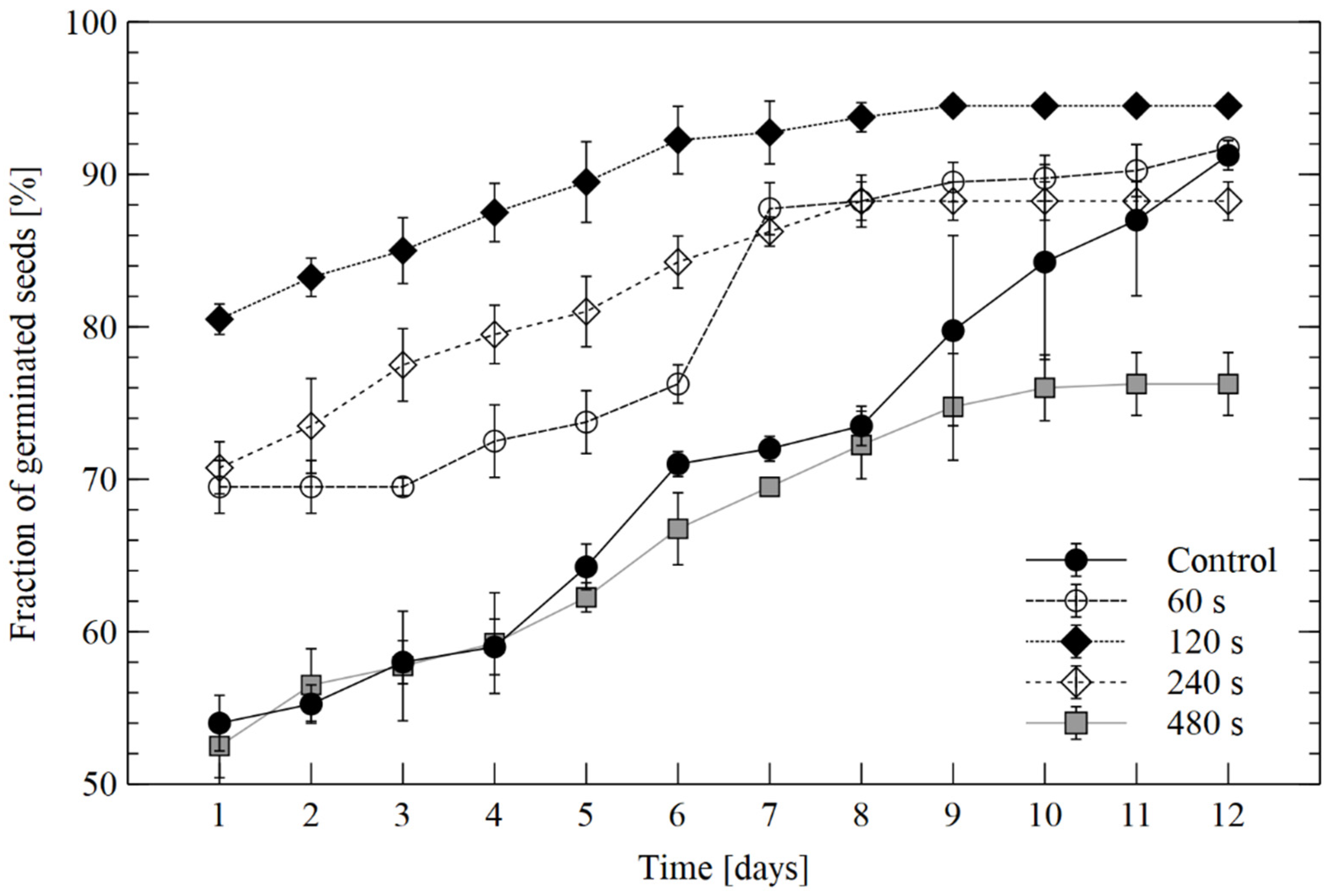
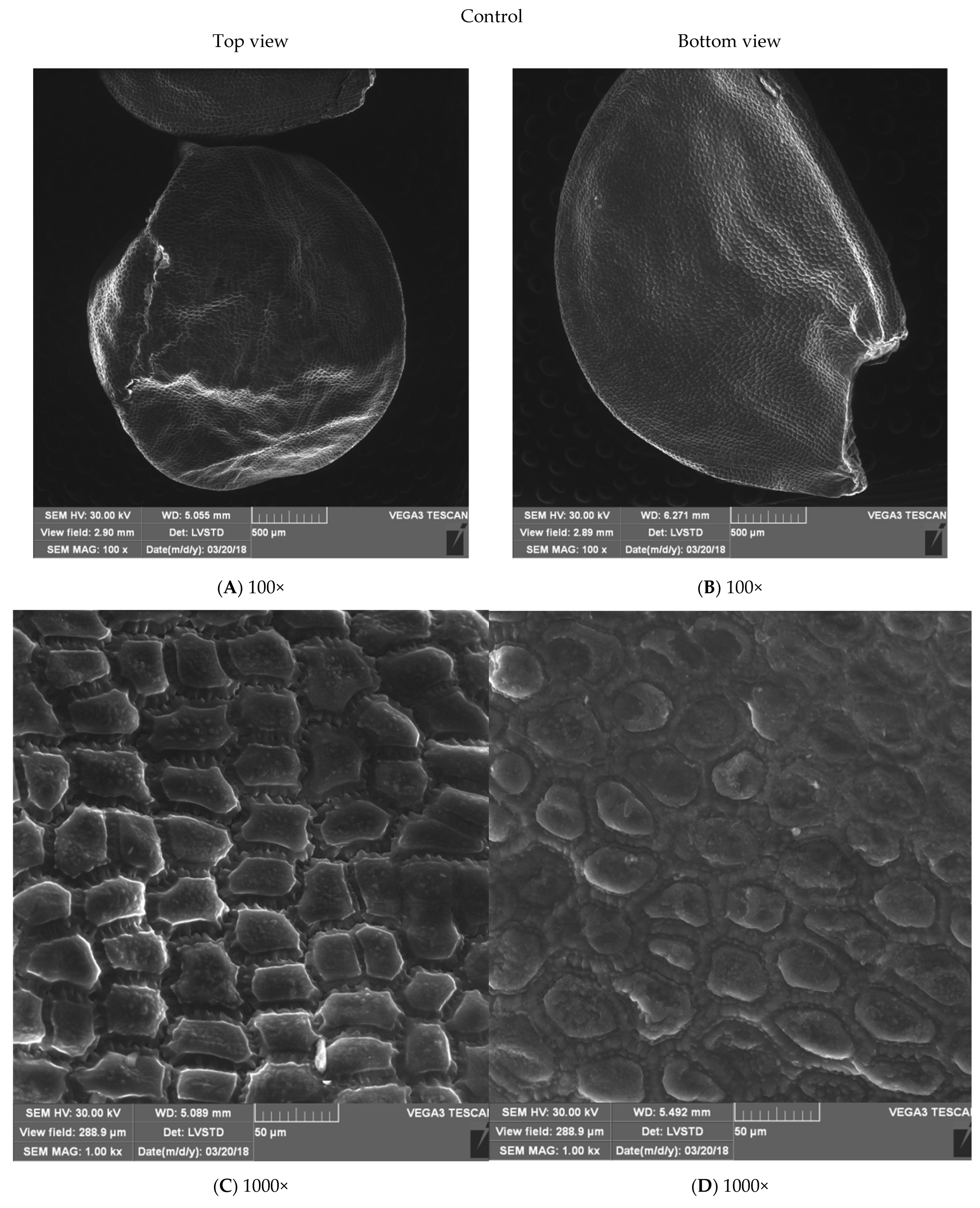

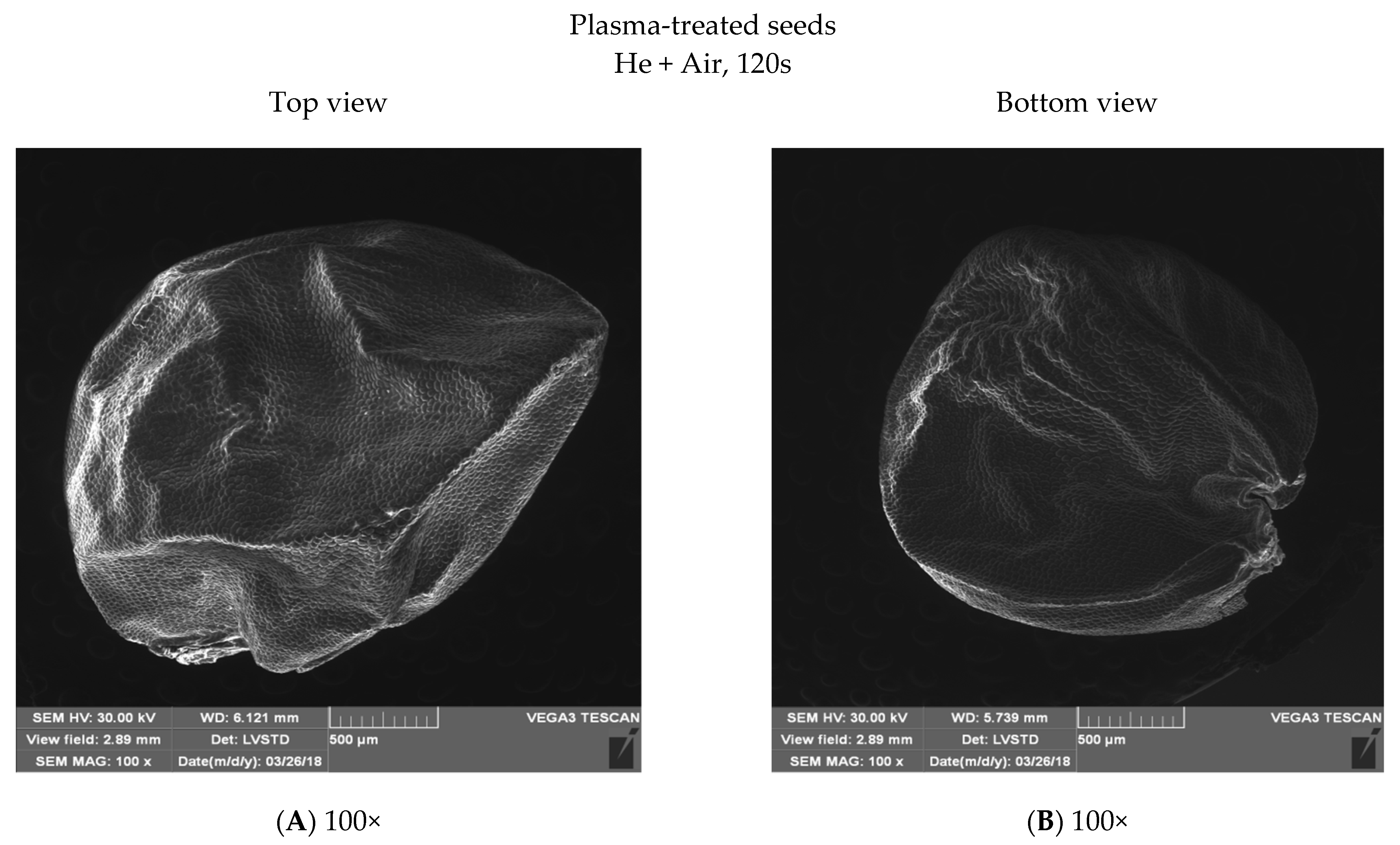
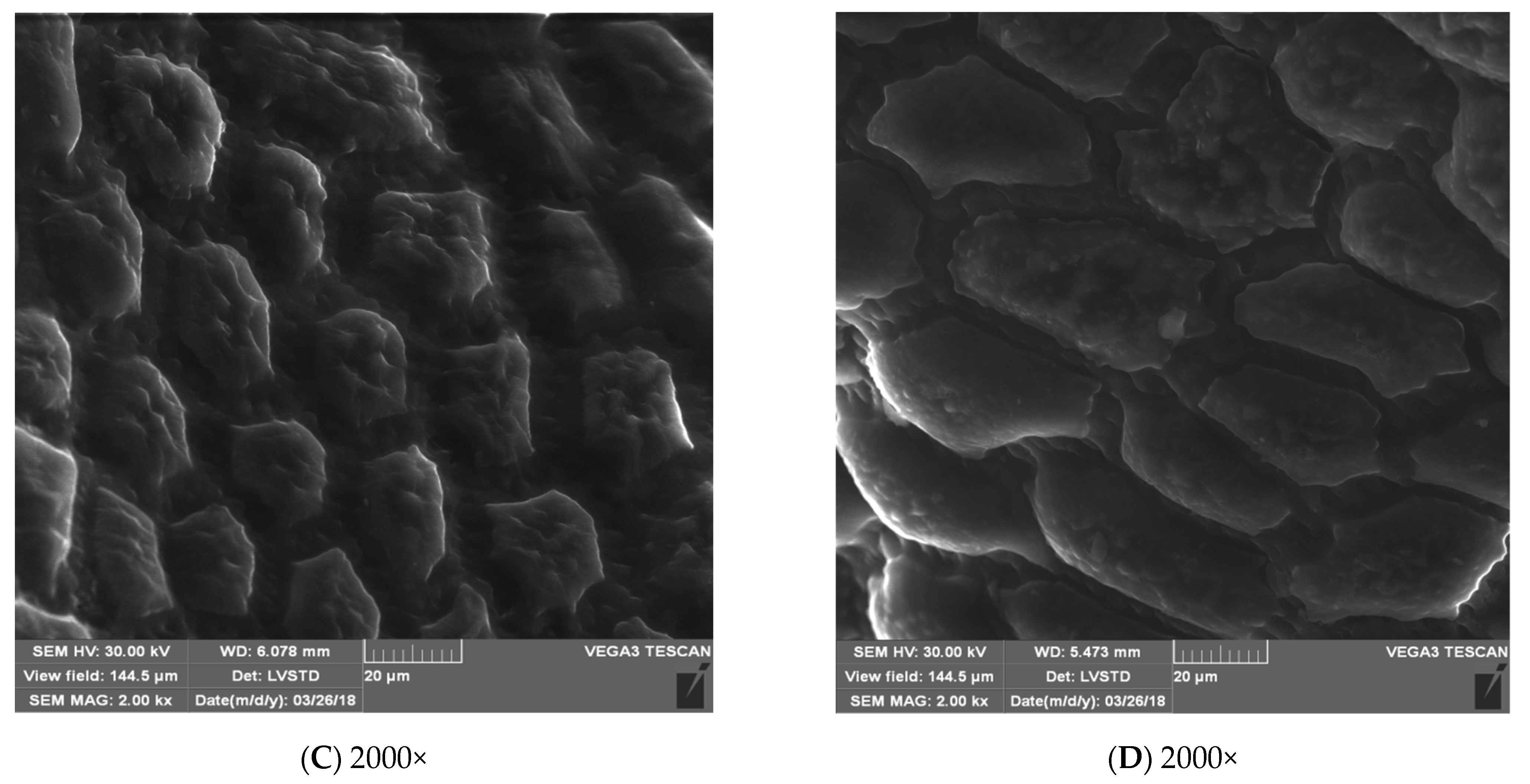

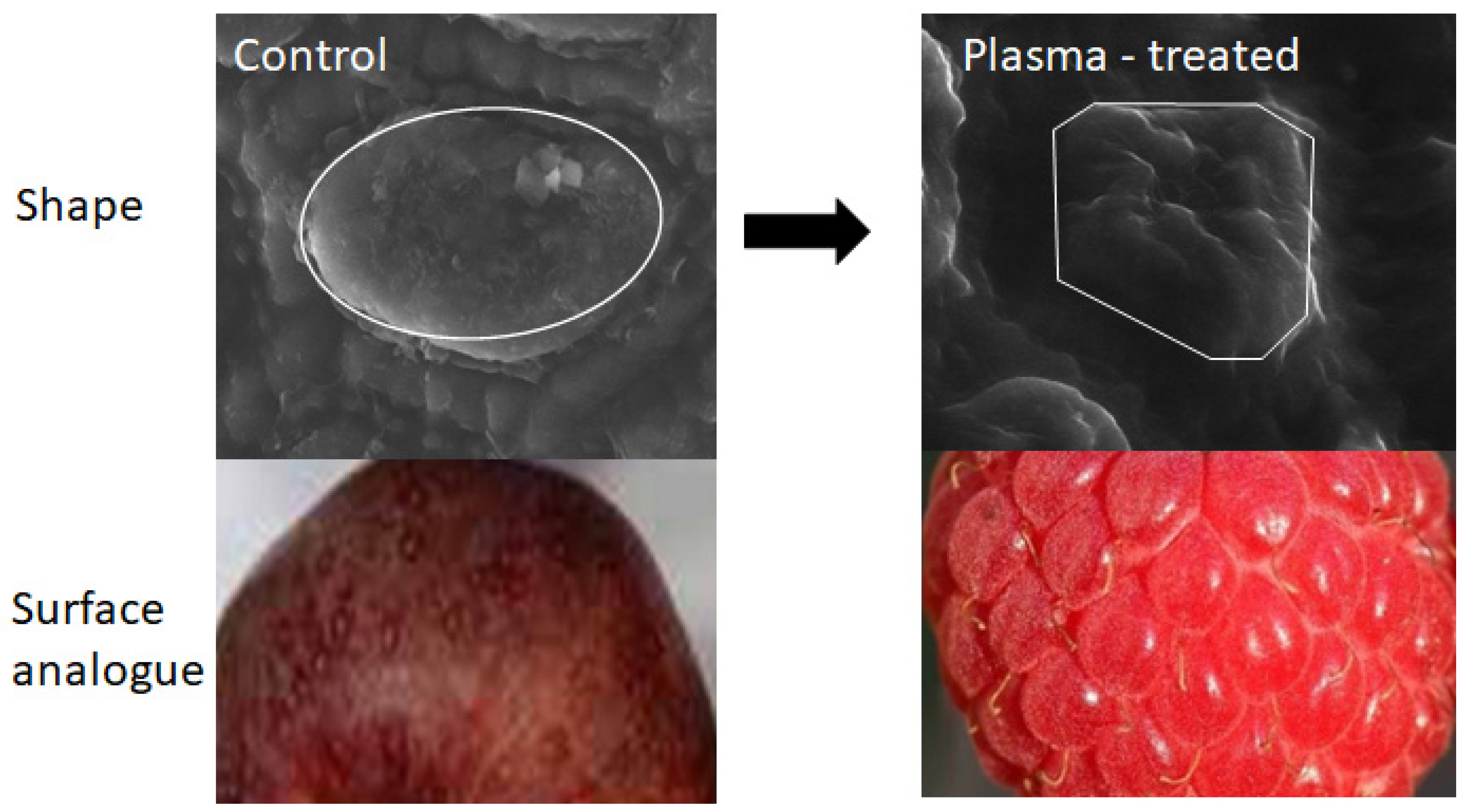
| Time of Stimulation (s) | Germination Energy GEN (%) | |
|---|---|---|
| Control-71.0 ± 0.82 a | ||
| He+O2 | He+Air | |
| 60 | 77.50 ± 2.38 c | 76.25 ± 1.26 c |
| 120 | 96.25 ± 1.89 f | 92.25 ± 2.22 d |
| 240 | 89.25 ± 0.96 d | 84.25 ± 1.71 e |
| 480 | 69.5 ± 0.58 ab | 66.75 ± 2.36 b |
| Time of Stimulation (s) | Germination Capacity GC (%) | |
|---|---|---|
| Control-91.25 ± 0.96 a | ||
| He+O2 | He+Air | |
| 60 | 89.25 ± 1.26 ab | 91.75 ± 0.5 ac |
| 120 | 99.25 ± 0.96 f | 94.50 ± 0.58 c |
| 240 | 89.75 ± 1.26 ab | 88.25 ± 1.26 b |
| 480 | 80.75 ± 1.71 e | 76.25 ± 2.06 d |
| Fungus Species | Exposure Time (s) | ||||
|---|---|---|---|---|---|
| Control | 60 s | 120 s | 240 s | 480 s | |
| Saprotrophic fungi | |||||
| Aspergillus niger van Tieghem | 10 ± 0.75 | 6 ± 0.70 | 5 ± 0.97 | 2 ± 0.42 | 3 ± 0.48 |
| Chaetomium globusom Kunze ex Fr. | 6 ± 0.53 | n.d. | 11 ± 0.88 | n.d. | n.d. |
| Epicoccum nigrum Link | 2 ± 0.53 | n.d. | n.d. | n.d. | n.d. |
| Gliocladium catenulatum Gill. et Abb. | 4 ± 0.58 | n.d. | n.d. | n.d. | n.d. |
| Penicillium spp. | 16 ± 0.74 | 11 ± 0.99 | 4 ± 0.51 | 14 ± 0.97 | 10 ± 1.05 |
| Rhizopus stolonifera Ehrenb. | 6 ± 1.62 | n.d. | n.d. | n.d. | n.d |
| Stemphylium botryotinum | 1 ± 0.63 | 4 ± 0.52 | n.d. | n.d. | n.d. |
| Trichoderma harzianum Rifai | 9 ± 1.06 | 2 ± 0.42 | 13 ± 0.82 | 4 ± 0.7 | 8 ± 0.63 |
| Trichoderma koningii Oud. | 5 ± 1.76 | n.d. | n.d. | n.d. | n.d. |
| Pathogenic fungi | |||||
| Alternaria alternata (Fr.) Keiss | 19 ± 1.26 | 6 ± 0.84 | 5 ± 0.84 | 2 ± 0.63 | 3 ± 0.67 |
| Botrytis cinerea Pers. ex Fries. | 8 ± 1.19 | 5 ± 0.52 | n.d. | n.d. | 9 ± 0.99 |
| Botrytis alli Munn. | 8 ± 0.48 | n.d. | n.d. | n.d. | n.d. |
| Fusarium avenaceum (Fr.) Sacc. | 5 ± 1.05 | n.d. | n.d. | n.d. | n.d. |
| Fusarium oxysporum Schlecht. | 16 ± 1.78 | 6 ± 0.96 | 3 ± 0.67 | 4 ± 0.84 | 4 ± 0.69 |
| Fusarium equiseti Link. | 4 ± 0.84 | n.d. | n.d. | n.d. | n.d. |
| Phoma glomerata | 1 ± 0.31 | n.d. | n.d. | n.d. | n.d. |
| Fungus Species | Exposure Time (s) | ||||
|---|---|---|---|---|---|
| Control | 60 s | 120 s | 240 s | 480 s | |
| Saprotrophic fungi | |||||
| Aspergillus niger van Tieghem | 10 ± 0.75 | 2 ± 0.63 | n.d. | n.d. | 2 ± 0.42 |
| Chaetomium globusom Kunze ex Fr. | 6 ± 0.53 | 5 ± 0.53 | 15 ± 0.85 | 11 ± 0.99 | n.d. |
| Epicoccum nigrum Link | 2 ± 0.53 | n.d. | 10 ± 1.25 | n.d. | n.d. |
| Gliocladium catenulatum Gill. et Abb. | 4 ± 0.58 | 4 ± 0.84 | n.d. | n.d. | n.d. |
| Penicillium spp. | 16 ± 0.74 | 14 ± 1.17 | 10 ± 1.15 | 2 ± 0.63 | 2 ± 0.42 |
| Rhizopus stolonifer Ehrenb. | 6 ± 1.62 | n.d. | 3 ± 0.48 | n.d. | 1 ± 0.31 |
| Stemphylium botryotinum | 1 ± 0.63 | n.d. | n.d. | n.d. | n.d. |
| Trichoderma harzianum Rifai | 9 ± 1.06 | 5 ± 0.71 | 12 ± 1.75 | 12 ± 0.92 | 2 ± 0.63 |
| Trichoderma koningii Oud. | 5 ± 1.76 | 3 ± 0.48 | 15 ± 1.18 | 11 ± 1.1 | 2 ± 0.42 |
| Pathogenic fungi | |||||
| Alternaria alternata (Fr.) Keiss | 19 ± 1.26 | 9 ± 0.57 | 11 ± 0.57 | 3 ± 0.48 | 2 ± 0.42 |
| Botrytis cinerea Pers. ex Fries. | 8 ± 1.19 | 3 ± 0.48 | n.d. | n.d. | n.d. |
| Botrytis alli Munn. | 8 ± 0.48 | n.d. | 3 ± 0.48 | 2 ± 0.42 | 3 ± 0.67 |
| Fusarium avenaceum (Fr.) Sacc. | 5 ± 1.05 | 10 ± 1.5 | 2 ± 0.63 | 2 ± 0.63 | 2 ± 0.63 |
| Fusarium oxysporum Schlecht. | 16 ± 1.78 | 2 ± 0.63 | 5 ± 0.53 | 2 ± 0.42 | 2 ± 0.42 |
| Fusarium equiseti Link. | 4 ± 0.84 | n.d. | n.d. | n.d. | n.d. |
| Phoma glomerata | 1 ± 0.31 | n.d. | n.d. | n.d. | n.d. |
Publisher’s Note: MDPI stays neutral with regard to jurisdictional claims in published maps and institutional affiliations. |
© 2022 by the authors. Licensee MDPI, Basel, Switzerland. This article is an open access article distributed under the terms and conditions of the Creative Commons Attribution (CC BY) license (https://creativecommons.org/licenses/by/4.0/).
Share and Cite
Pawłat, J.; Starek-Wójcicka, A.; Kopacki, M.; Terebun, P.; Kwiatkowski, M.; Sujak, A.; Pascuzzi, S.; Santoro, F.; Andrejko, D. Germination Energy, Germination Capacity and Microflora of Allium cepa L. Seeds after RF Plasma Conditioning. Energies 2022, 15, 7687. https://doi.org/10.3390/en15207687
Pawłat J, Starek-Wójcicka A, Kopacki M, Terebun P, Kwiatkowski M, Sujak A, Pascuzzi S, Santoro F, Andrejko D. Germination Energy, Germination Capacity and Microflora of Allium cepa L. Seeds after RF Plasma Conditioning. Energies. 2022; 15(20):7687. https://doi.org/10.3390/en15207687
Chicago/Turabian StylePawłat, Joanna, Agnieszka Starek-Wójcicka, Marek Kopacki, Piotr Terebun, Michał Kwiatkowski, Agnieszka Sujak, Simone Pascuzzi, Francesco Santoro, and Dariusz Andrejko. 2022. "Germination Energy, Germination Capacity and Microflora of Allium cepa L. Seeds after RF Plasma Conditioning" Energies 15, no. 20: 7687. https://doi.org/10.3390/en15207687
APA StylePawłat, J., Starek-Wójcicka, A., Kopacki, M., Terebun, P., Kwiatkowski, M., Sujak, A., Pascuzzi, S., Santoro, F., & Andrejko, D. (2022). Germination Energy, Germination Capacity and Microflora of Allium cepa L. Seeds after RF Plasma Conditioning. Energies, 15(20), 7687. https://doi.org/10.3390/en15207687









